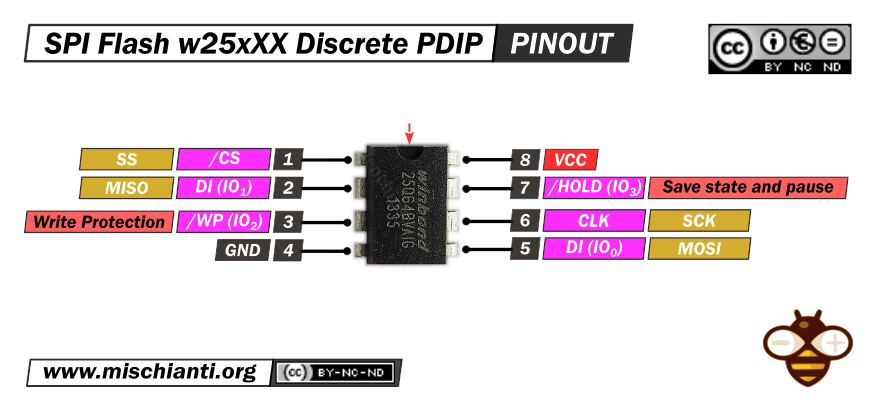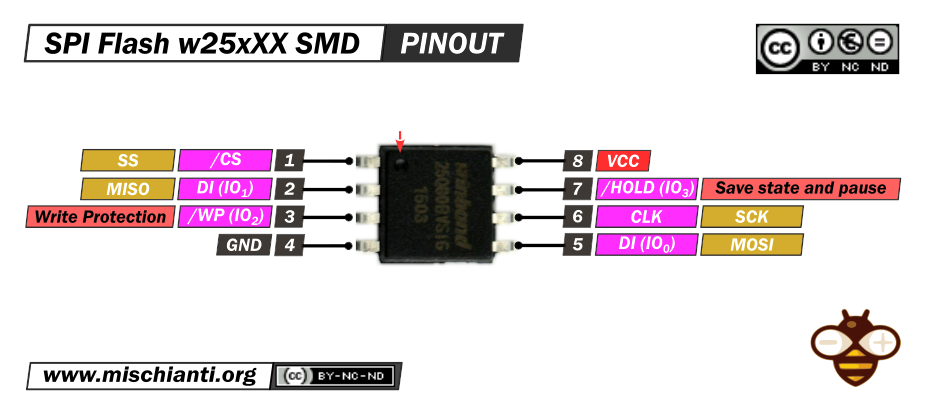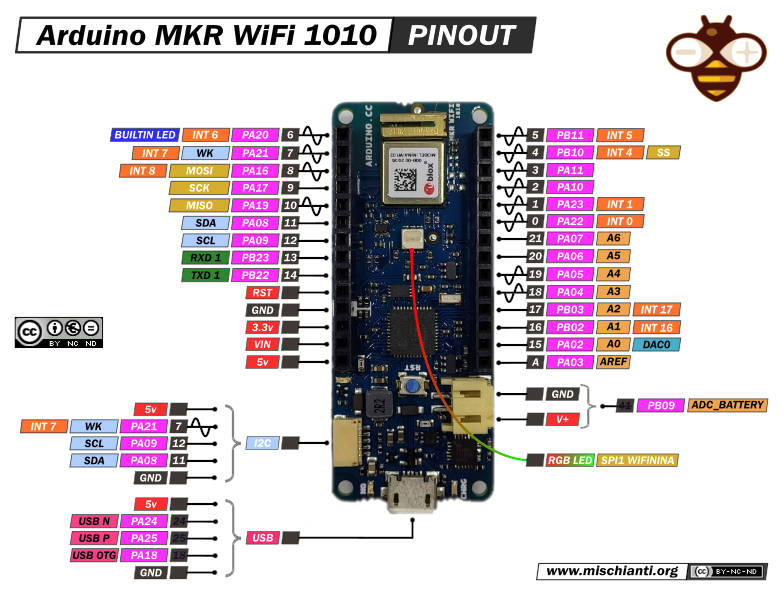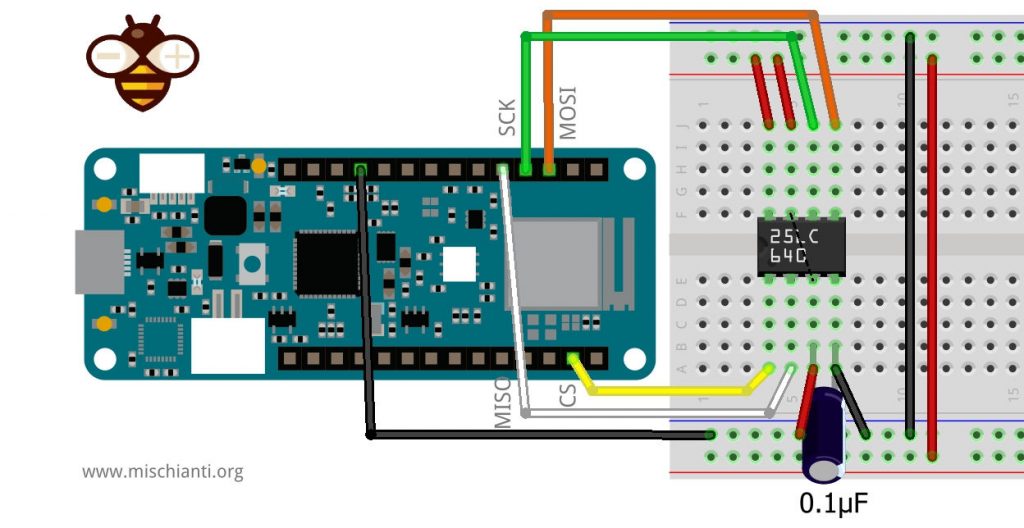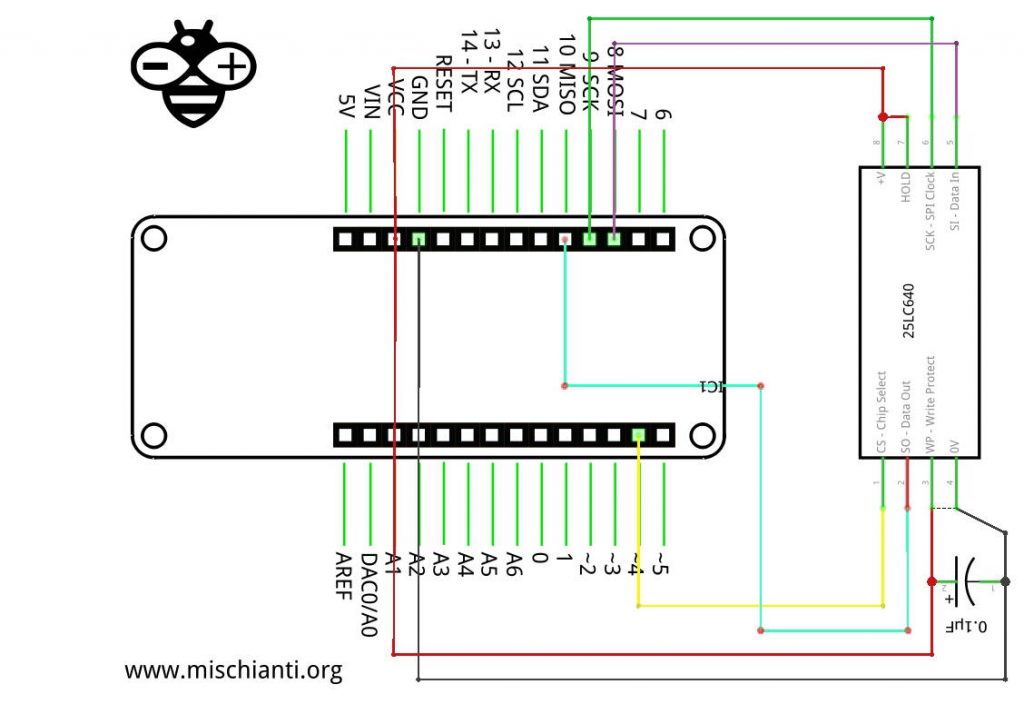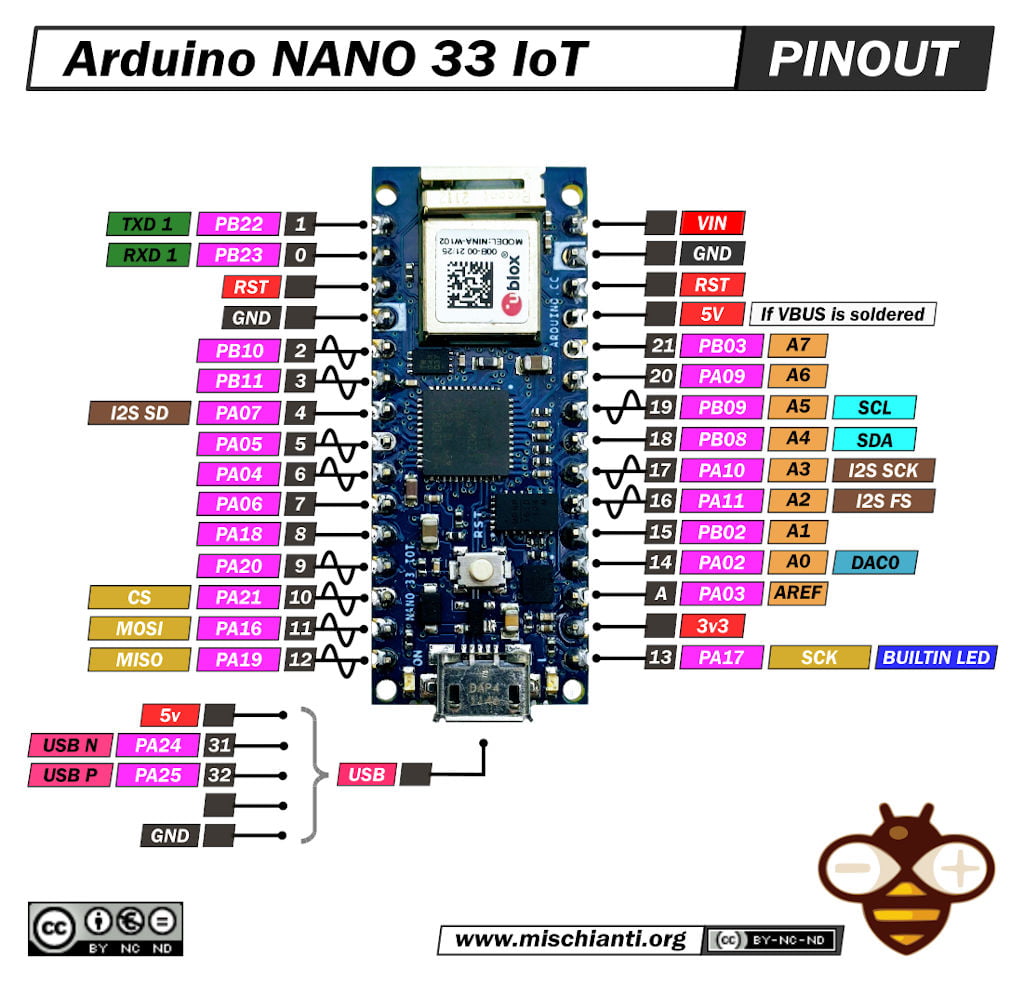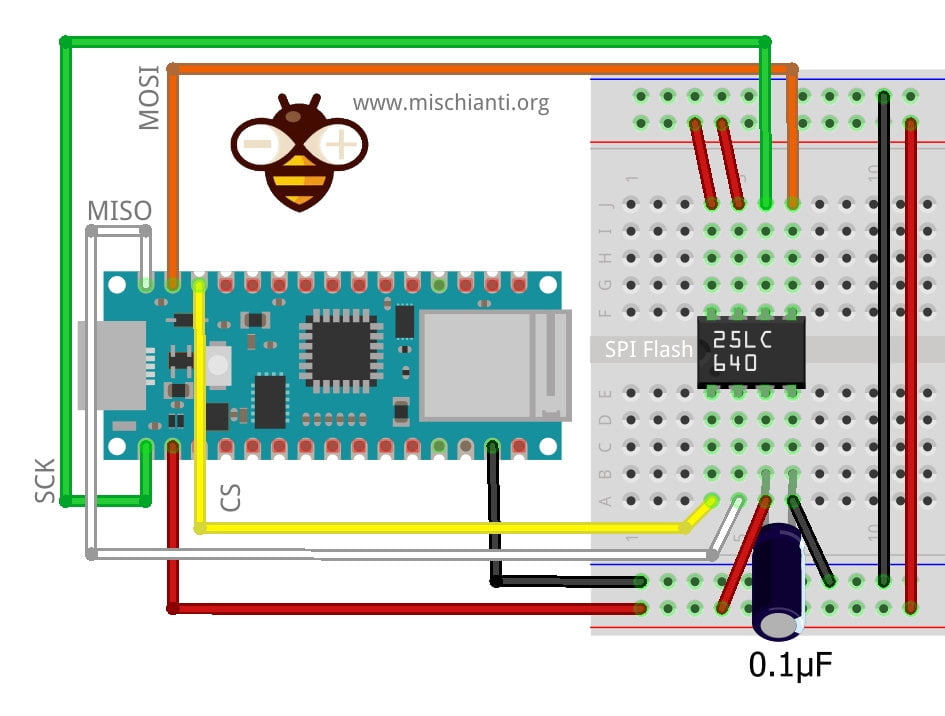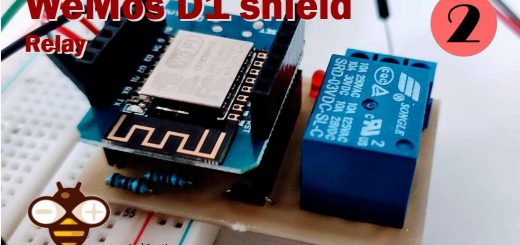Arduino SAMD (NANO 33 and MKR): SPI flash memory FAT FS
Arduino SAMD devices don’t have an internal SPI flash memory, but it is clear that a fast and small memory like that can be very useful, so we are to talk again (and again and again and again…) about storage systems.
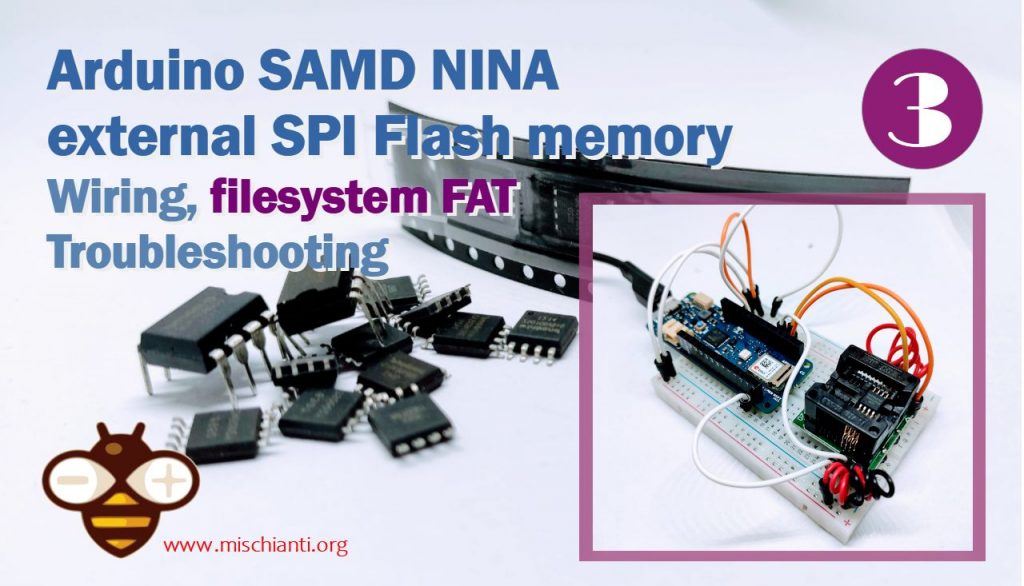
We already had explained SD management (you can look at SD management on “How to use SD card with esp8266 and Arduino“), now we’d like to look at alternative storage like external SPI flash, similar to the EEPROM but with the biggest size. The SPI flash has a smaller capacity but is small, fast, and has very low power consumption. SD It’s surely the best choice for size and compatibility, but we pay for these features with a good quantity of energy.
Today, we will see the SPI flash memory (NOR Flash); they are a single chip that can be managed via SPI and have high-speed access and low power consumption.
Flash memory is an electronic non-volatile computer memory storage medium that can be electrically erased and reprogrammed. The two main types of flash memory, NOR flash and NAND flash, are named for the NOR and NAND logic gates. NAND flash and NOR flash use the same cell design, consisting of floating gate MOSFETs. They differ at the circuit level: in NAND flash, the relationship between the bit line and the word lines resembles a NAND gate; in NOR flash, it resembles a NOR gate; this depends on whether the state of the bit line or word lines is pulled high or low.
Wikipedia
Flash memory, a type of floating-gate memory, was invented at Toshiba in 1980 and is based on EEPROM technology. Toshiba began marketing flash memory in 1987. EPROMs had to be erased completely before they could be rewritten. NAND flash memory, however, may be erased, written, and read in blocks (or pages), which generally are much smaller than the entire device. NOR flash memory allows a single machine word to be written – to an erased location – or read independently. A flash memory device typically consists of one or more flash memory chips (each holding many flash memory cells), along with a separate flash memory controller chip.
Flash memories
There are SMD, and Discrete IC managed by SPI protocol.
Here a set of SPI flash with different size w25q16 SMD 2Mb - w25q16 Discrete 2Mb - w25q32 SMD 4Mb - w25q32 Discrete 4Mb - w25q64 SMD 8Mb - w25q64 Discrete 8Mb - w25q128 SMD 16Mb - w25q128 Discrete 16Mb W25Q32 W25Q64 w25q128 module 4Mb 8Mb 16Mb
Arduino MKR WiFi 1010 wiring diagram
You can select a SERCOM SPI in all pins you want, but now we are going to use standard SPI.
So you can refer to the pinout and connect pins 8, 9, 10, and 4 for CS.
| Arduino | SPI flash | |
|---|---|---|
| 4 | /CS | Pulled UP if not standard CS |
| 10 | DI (IO1) | |
| 8 | DI (IO0) | |
| 9 | CLK | |
| 3.3v | /WP | |
| 3.3v | /Hold | |
| GND | GND | |
| 3.3v | VCC |
For the capacitor, I use a 0.1μF, and It works correctly, but the standard value was 0.01μF.
Arduino NANO 33 IoT wiring diagram
Also in this case, you can select SERCOM SPI in all pins you want, but now we are going to use standard SPI.
So you can refer to the pinout and connect pins 11, 12, 13, and 10 for CS.
| Arduino | SPI flash | |
|---|---|---|
| 10 | /CS | Pulled UP if not standard CS |
| 12 | DI (IO1) | |
| 11 | DI (IO0) | |
| 13 | CLK | |
| 3.3v | /WP | |
| 3.3v | /Hold | |
| GND | GND | |
| 3.3v | VCC |
For the capacitor, I used a 0.1μF, and It works correctly, but the standard value was 0.01μF.
SPI flash basic usage
If you don’t need a particular data structure, you can do basic and raw usage of the SPI flash.
For additional information on this library, you can see the article “Arduino: external fast SPI Flash memory“.
For basic usage, I advise using a library named SPIMemory, which is quite simple but with good support without difficulty. You can download It via the library manager from Arduino IDE.
You must block the frequencies to 12Mhz for this device because the sercom interface doesn’t permit more. But you can theoretically open five different SPI devices.
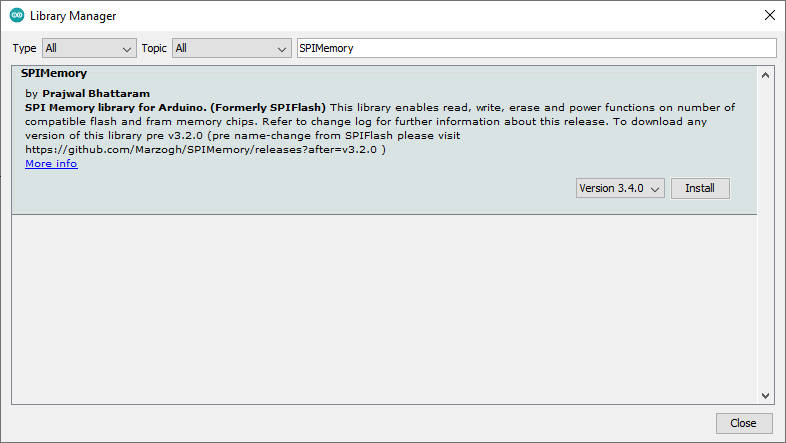
Here is a simple example that stores a JSON string in the initial address 0, and I re-read It, then I ask the method getAddress for the first available contiguous position where I can store another JSON string, and I save It and re-read.
/*
* Manage external SPI Flash with Arduino
* Write and read a JSON structure like a String,
* find first address available
* and write and read another JSON structure
*
* with library SPIMemory
*
* by Mischianti Renzo <https://mischianti.org>
*
* https://mischianti.org/
*
* SPIFlash connected via SPI standard
*
*/
#include <SPIMemory.h>
#include <ArduinoJson.h>
//SPIFlash flash; // If you don't specify the library use standard SPI connection
SPIFlash flash(SS, &SPI);
void setup() {
Serial.begin(115200);
while (!Serial) ; // Wait for Serial monitor to open
delay(100);
flash.setClock(12000000); // uncomment here for Arduino SAMD boards
flash.begin(); // If SPIMemory isn't recognized you can specify the size of memory
// flash.eraseChip();
Serial.print(F("Flash size: "));
Serial.print((long)(flash.getCapacity()/1000));
Serial.println(F("Kb"));
unsigned long strAddr = 0;
unsigned long strAddrSecondString = 0;
Serial.println();
// Allocate a temporary JsonDocument
// Don't forget to change the capacity to match your requirements.
// Use arduinojson.org/v6/assistant to compute the capacity.
// StaticJsonDocument<512> doc;
// You can use DynamicJsonDocument as well
Serial.println(F("Generate JSON file!"));
DynamicJsonDocument doc(512);
// Set the values in the document
doc["energyLifetime"] = 21698620;
doc["energyYearly"] = 1363005;
Serial.print(F("Put data in a buffer.. "));
// Serialize JSON to file
String buf;
if (serializeJson(doc, buf) == 0) {
Serial.println(F("failed to write buffer"));
}
if (flash.writeStr(strAddr, buf)){
Serial.print(F("OK, writed on address "));
Serial.println(strAddr);
}else{
Serial.println(F("KO"));
}
String outputString = "";
if (flash.readStr(strAddr, outputString)) {
Serial.print(F("Read json: "));
Serial.println(outputString);
Serial.print(F("From address: "));
Serial.println(strAddr);
}
Serial.println(F("Generate JSON file!"));
DynamicJsonDocument doc2(512);
// Set the values in the document
doc2["energyLifetime"] = 222;
doc2["energyYearly"] = 333;
Serial.println();
Serial.print(F("Check first free sector: "));
strAddrSecondString = flash.getAddress(doc2.size());
Serial.println(strAddrSecondString);
Serial.println();
Serial.print(F("Stream data in flash memory!"));
Serial.print(F("Put data in a buffer.."));
// Serialize JSON to file
String buf2;
if (serializeJson(doc2, buf2) == 0) {
Serial.println(F("failed to write buffer"));
}
// Print test file
if (flash.writeStr(strAddrSecondString, buf2)){
Serial.print(F("OK, writed on address "));
Serial.println(strAddrSecondString);
}else{
Serial.println(F("KO"));
}
String outputString2 = "";
if (flash.readStr(strAddrSecondString, outputString2)) {
Serial.print(F("Read data: "));
Serial.println(outputString2);
Serial.print(F("From address: "));
Serial.println(strAddrSecondString);
}
while (!flash.eraseSector(strAddr));
while (!flash.eraseSector(strAddrSecondString));
}
void loop() {
}
Here is the console result.
Flash size: 8388Kb
Generate JSON file!
Put data in a buffer.. OK, writed on address 0
Read json: {"energyLifetime":21698620,"energyYearly":1363005}
From address: 0
Generate JSON file!
Check first free sector: 56
Stream data in flash memory!Put data in a buffer..OK, writed on address 56
Read data: {"energyLifetime":222,"energyYearly":333}
From address: 56
SPI flash advanced use with SdFat filesystem
A more complex library (and more hungry of resources) It’s the Adafruit one, the Adafruit SPIFlash, that needs to be used with the SdFat Adafruit fork.
This library Is discouraged on Arduino boards like UNO or Mega because only for the buffer It needs 512 bytes, and every file has some byte of the preamble, and you risk wasting a lot of RAM.
For a low-power microcontroller, It’s better to use a library like SPIMemory.
You can also find these libraries on the library manager “Adafruit SPIFlash” and “SdFat – Adafruit Fork”.
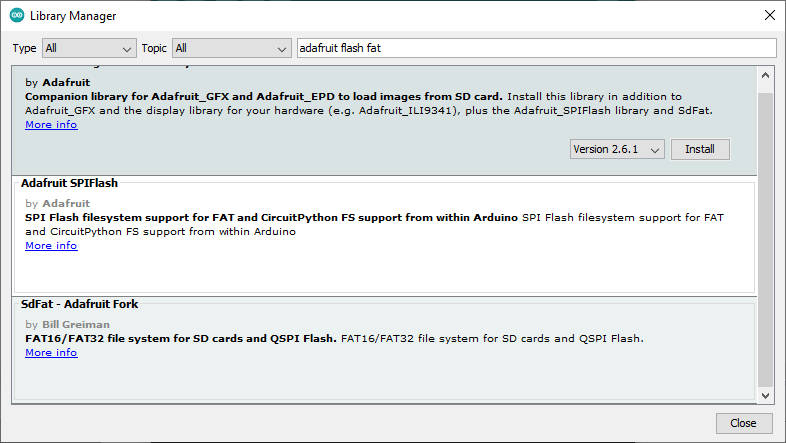
Add new SPI flash type
The supported chip set is limited to a specified list, but a new device can be created. For example, I have a W25X80AVAIZ (I think Winbond clone), a decent component that you can buy for a very low price.
It has these characteristics:
- 1Mb capacity;
- 104Mhz of speed;
- Winbond clone;
- Single dual and quad SPI.
Now, I write a simple sketch to check the compatibility:
/*
* Retrieve basic core info of Flash SPI
* Add a custom device w25x80
* library Adafruit_SPIFlash and SdFat - AdafruitFork
*
* by Mischianti Renzo <https://mischianti.org>
*
* https://mischianti.org/
*
* SPIFlash connected via SPI standard check wiring on the article
*
*/
#include "SdFat.h"
#include "Adafruit_SPIFlash.h"
Adafruit_FlashTransport_SPI flashTransport(SS, SPI); // Set CS and SPI interface
Adafruit_SPIFlash flash(&flashTransport);
void setup()
{
Serial.begin(115200);
while ( !Serial ) delay(100); // wait for native usb
if (flash.begin()) {
Serial.println(F("Device finded and supported!"));
} else {
Serial.println(F("Problem to discover and configure device, check wiring also!"));
}
// Set 4Mhz SPI speed
flashTransport.setClockSpeed(4000000, 4000000); // added to prevent speed problem
Serial.println();
Serial.println("Adafruit Serial Flash get basic info: ");
Serial.print("JEDEC ID (FFFFFF for unknown): "); Serial.println(flash.getJEDECID(), HEX);
Serial.print("Flash size: "); Serial.println(flash.size());
Serial.println();Serial.println();
uint8_t jedec_ids[4];
flashTransport.readCommand(SFLASH_CMD_READ_JEDEC_ID, jedec_ids, 4);
// For simplicity with commonly used device, we only check for continuation
// code at 2nd byte (e.g Fujitsu FRAM devices)
if (jedec_ids[1] == 0x7F) {
// Shift and skip continuation code in 2nd byte
jedec_ids[1] = jedec_ids[2];
jedec_ids[2] = jedec_ids[3];
}
Serial.println("Retrieve JDEC_ID");
Serial.print("Manufacturer ID: 0x");
Serial.println(jedec_ids[0], HEX);
Serial.print("Memory Type: 0x");
Serial.println(jedec_ids[1], HEX);
Serial.print("Capacity: 0x");
Serial.println(jedec_ids[2], HEX);
Serial.print("Capacity DEC: ");
Serial.println(jedec_ids[2], DEC);
}
void loop()
{
// nothing to do
}
The serial output for my unsupported device is:
Unknown flash device 0xEF4014
Problem to discover and configure device, check wiring also!
Adafruit Serial Flash get basic info:
JEDEC ID (FFFFFF for unknown): FFFFFF
Flash size: 0
Retrieve JDEC_ID
Manufacturer ID: 0xEF
Memory Type: 0x40
Capacity: 0x14
Capacity DEC: 20
So I get from the Adafruit_SPIFlash library the file flash_devices.h, and I select the most similar device is in the list.
Then I use:
Capacity DEC to get the size: .total_size = (1UL << 20), /* 1 MiB */
Manufacturer ID for the manufacturer: .manufacturer_id = 0xef
Memory type for the memory_type: .memory_type = 0x40
The Capacity for capacity: .capacity = 0x14
I try to find some information on the compatible device datasheet.
// Settings for the Winbond W25Q80BV (1 MiB SPI flash.)
// https://pdf1.alldatasheet.com/datasheet-pdf/view/555565/WINBOND/W25Q80BV.html
#define W25X80BV \
{ \
.total_size = (1UL << 20), /* 1 MiB */ \
.start_up_time_us = 5000, .manufacturer_id = 0xef, \
.memory_type = 0x40, .capacity = 0x14, .max_clock_speed_mhz = 104, \
.quad_enable_bit_mask = 0x02, .has_sector_protection = false, \
.supports_fast_read = true, .supports_qspi = true, \
.supports_qspi_writes = true, .write_status_register_split = false, \
.single_status_byte = false, .is_fram = false, \
}
static const SPIFlash_Device_t possible_devices[] = {
W25X80BV,
};
// Initialize flash library and check its chip ID.
if (!flash.begin(possible_devices)) {
Serial.println("Error, failed to initialize flash chip!");
while(1) yield();
}
Now the complete test sketch becomes:
/*
* Retrieve basic core info of Flash SPI
* Add a custom device w25x80
* library Adafruit_SPIFlash and SdFat - AdafruitFork
*
* by Mischianti Renzo <https://mischianti.org>
*
* https://mischianti.org/
*
* SPIFlash connected via SPI standard check wiring on the article
*
*/
#include "SdFat.h"
#include "Adafruit_SPIFlash.h"
Adafruit_FlashTransport_SPI flashTransport(SS, SPI); // Set CS and SPI interface
Adafruit_SPIFlash flash(&flashTransport);
void setup()
{
Serial.begin(115200);
while ( !Serial ) delay(100); // wait for native usb
// Settings for the Winbond W25Q80BV (1 MiB SPI flash.)
// https://pdf1.alldatasheet.com/datasheet-pdf/view/555565/WINBOND/W25Q80BV.html
#define W25X80BV \
{ \
.total_size = (1UL << 20), /* 1 MiB */ \
.start_up_time_us = 5000, .manufacturer_id = 0xef, \
.memory_type = 0x40, .capacity = 0x14, .max_clock_speed_mhz = 104, \
.quad_enable_bit_mask = 0x02, .has_sector_protection = false, \
.supports_fast_read = true, .supports_qspi = true, \
.supports_qspi_writes = true, .write_status_register_split = false, \
.single_status_byte = false, .is_fram = false, \
}
static const SPIFlash_Device_t possible_devices[] = {
W25X80BV,
};
if (flash.begin(possible_devices)) {
Serial.println(F("Device finded and supported!"));
} else {
Serial.println(F("Problem to discover and configure device, check wiring also!"));
}
// Set 4Mhz SPI speed
flashTransport.setClockSpeed(4000000, 4000000); // added to prevent speed problem
Serial.println();
Serial.println("Adafruit Serial Flash get basic info: ");
Serial.print("JEDEC ID (FFFFFF for unknown): "); Serial.println(flash.getJEDECID(), HEX);
Serial.print("Flash size: "); Serial.println(flash.size());
Serial.println();Serial.println();
uint8_t jedec_ids[4];
flashTransport.readCommand(SFLASH_CMD_READ_JEDEC_ID, jedec_ids, 4);
// For simplicity with commonly used device, we only check for continuation
// code at 2nd byte (e.g Fujitsu FRAM devices)
if (jedec_ids[1] == 0x7F) {
// Shift and skip continuation code in 2nd byte
jedec_ids[1] = jedec_ids[2];
jedec_ids[2] = jedec_ids[3];
}
Serial.println("Retrieve JDEC_ID");
Serial.print("Manufacturer ID: 0x");
Serial.println(jedec_ids[0], HEX);
Serial.print("Memory Type: 0x");
Serial.println(jedec_ids[1], HEX);
Serial.print("Capacity: 0x");
Serial.println(jedec_ids[2], HEX);
Serial.print("Capacity DEC: ");
Serial.println(jedec_ids[2], DEC);
}
void loop()
{
// nothing to do
}
And now the result is:
Device finded and supported!
Adafruit Serial Flash get basic info:
JEDEC ID (FFFFFF for unknown): EF4014
Flash size: 1048576
Retrieve JDEC_ID
Manufacturer ID: 0xEF
Memory Type: 0x40
Capacity: 0x14
Capacity DEC: 20
Test and Troubleshooting
To check if all It’s ok, you can use the test given in the library. First, you must launch the example SdFat_speedtest; for Arduino UNO, like the board with little RAM, you must reduce the buffer from
#define BUFSIZE 4096
to
#define BUFSIZE 512
here is the complete sketch with custom IC:
// The MIT License (MIT)
// Copyright (c) 2019 Ha Thach for Adafruit Industries
#include "SdFat.h"
#include "Adafruit_SPIFlash.h"
// Uncomment to run example with custom SPI and SS e.g with FRAM breakout
#define CUSTOM_CS SS
#define CUSTOM_SPI SPI
#define EXTERNAL_FLASH_USE_QSPI
Adafruit_FlashTransport_SPI flashTransport(CUSTOM_CS, CUSTOM_SPI);
Adafruit_SPIFlash flash(&flashTransport);
#define BUFSIZE 4096
// 4 byte aligned buffer has best result with nRF QSPI
uint8_t bufwrite[BUFSIZE] __attribute__ ((aligned(4)));
uint8_t bufread[BUFSIZE] __attribute__ ((aligned(4)));
// the setup function runs once when you press reset or power the board
void setup()
{
Serial.begin(115200);
while ( !Serial ) delay(100); // wait for native usb
// SPI.setFrequency(12000000);
// Settings for the Winbond W25Q80BV (1 MiB SPI flash.)
// https://pdf1.alldatasheet.com/datasheet-pdf/view/555565/WINBOND/W25Q80BV.html
#define W25X80BV \
{ \
.total_size = (1UL << 20), /* 1 MiB */ \
.start_up_time_us = 5000, .manufacturer_id = 0xef, \
.memory_type = 0x40, .capacity = 0x14, .max_clock_speed_mhz = 104, \
.quad_enable_bit_mask = 0x02, .has_sector_protection = false, \
.supports_fast_read = true, .supports_qspi = true, \
.supports_qspi_writes = true, .write_status_register_split = false, \
.single_status_byte = false, .is_fram = false, \
}
/// List of all possible flash devices used by Adafruit boards
static const SPIFlash_Device_t possible_devices[] = {
// Main devices used in current Adafruit products
W25X80BV,
};
// flash.begin(possible_devices); // custom board
flash.begin(); // start with standard board
pinMode(LED_BUILTIN, OUTPUT);
flash.setIndicator(LED_BUILTIN, true);
Serial.println("Adafruit Serial Flash Speed Test example");
Serial.print("JEDEC ID: "); Serial.println(flash.getJEDECID(), HEX);
Serial.print("Flash size: "); Serial.println(flash.size());
Serial.flush();
write_and_compare(0xAA);
write_and_compare(0x55);
Serial.println("Speed test is completed.");
Serial.flush();
}
void print_speed(const char* text, uint32_t count, uint32_t ms)
{
Serial.print(text);
Serial.print(count);
Serial.print(" bytes in ");
Serial.print(ms / 1000.0F, 2);
Serial.println(" seconds.");
Serial.print("Speed : ");
Serial.print( (count / 1000.0F) / (ms / 1000.0F), 2);
Serial.println(" KB/s.\r\n");
}
bool write_and_compare(uint8_t pattern)
{
uint32_t ms;
Serial.println("Erase chip");
Serial.flush();
#define TEST_WHOLE_CHIP
#ifdef TEST_WHOLE_CHIP
uint32_t const flash_sz = flash.size();
flash.eraseChip();
#else
uint32_t const flash_sz = 4096;
flash.eraseSector(0);
#endif
flash.waitUntilReady();
// write all
memset(bufwrite, (int) pattern, sizeof(bufwrite));
Serial.printf("Write flash with 0x%02X\n", pattern);
Serial.flush();
ms = millis();
for(uint32_t addr = 0; addr < flash_sz; addr += sizeof(bufwrite))
{
flash.writeBuffer(addr, bufwrite, sizeof(bufwrite));
}
uint32_t ms_write = millis() - ms;
print_speed("Write ", flash_sz, ms_write);
Serial.flush();
// read and compare
Serial.println("Read flash and compare");
Serial.flush();
uint32_t ms_read = 0;
for(uint32_t addr = 0; addr < flash_sz; addr += sizeof(bufread))
{
memset(bufread, 0, sizeof(bufread));
ms = millis();
flash.readBuffer(addr, bufread, sizeof(bufread));
ms_read += millis() - ms;
if ( memcmp(bufwrite, bufread, BUFSIZE) )
{
Serial.printf("Error: flash contents mismatched at address 0x%08X!!!", addr);
for(uint32_t i=0; i<sizeof(bufread); i++)
{
if ( i != 0 ) Serial.print(' ');
if ( (i%16 == 0) )
{
Serial.println();
Serial.printf("%03X: ", i);
}
Serial.printf("%02X", bufread[i]);
}
Serial.println();
return false;
}
}
print_speed("Read ", flash_sz, ms_read);
Serial.flush();
return true;
}
void loop()
{
// nothing to do
}
If you have a Serial output like this (I use […] to indicate the line replication):
Adafruit Serial Flash Speed Test example
JEDEC ID: EF4014
Flash size: 1048576
Erase chip
Write flash with 0xAA
Write 1048576 bytes in 1.03 seconds.
Speed : 1016.06 KB/s.
Read flash and compare
Error: flash contents mismatched at address 0x00000000!!!
000: 00 00 00 00 00 00 00 00 00 00 00 00 00 00 00 00
[...]
FF0: 00 00 00 00 00 00 00 00 00 00 00 00 00 00 00 00
Erase chip
Write flash with 0x55
Write 1048576 bytes in 1.03 seconds.
Speed : 1017.05 KB/s.
Read flash and compare
Error: flash contents mismatched at address 0x00000000!!!
000: 00 00 00 00 00 00 00 00 00 00 00 00 00 00 00 00
[...]
FF0: 00 00 00 00 00 00 00 00 00 00 00 00 00 00 00 00
Speed test is completed.
The lines (or other HEX characters) with
000: 00 00 00 00 00 00 00 00 00 00 00 00 00 00 00 00
indicate that the data compared don’t match, so (If the previous test sketch work) probably you had some problem.
In most cases, the SPI speed is too high; this does not mean that the speed is too high for the microcontroller or IC, but it can be a problem with a poor connection cable.
This library supports Arduino MKR SAMD very well, so you don’t have to do anything. We will see more in the next paragraph.
But if the solution was to reduce the speed, you have to add a line like this after flash.begin():
flashTransport.setClockSpeed(24000000, 24000000);
the command set the SPI speed to 24Mhz, and now the result becomes like so:
Adafruit Serial Flash Speed Test example
JEDEC ID: EF4014
Flash size: 1048576
Erase chip
Write flash with 0xAA
Write 1048576 bytes in 4.07 seconds.
Speed : 257.38 KB/s.
Read flash and compare
Read 1048576 bytes in 0.47 seconds.
Speed : 2226.28 KB/s.
Erase chip
Write flash with 0x55
Write 1048576 bytes in 4.07 seconds.
Speed : 257.38 KB/s.
Read flash and compare
Read 1048576 bytes in 0.47 seconds.
Speed : 2231.01 KB/s.
Speed test is completed.
If no compare errors are shown, the SPI Flash was correctly configured.
Arduino SAMD limitations
For Arduino SAMD devices, the library internally blocks the max speed to 12MHz, which is the limit of the sercom interface, but you can create all SPI connections you want.
#if defined(ARDUINO_ARCH_SAMD) && !defined(__SAMD51__)
// Hand-on testing show that SAMD21 M0 can write up to 24 Mhz,
// but can only read reliably at 12 Mhz
rd_speed = min(12000000, rd_speed);
#endif
Practical sketch
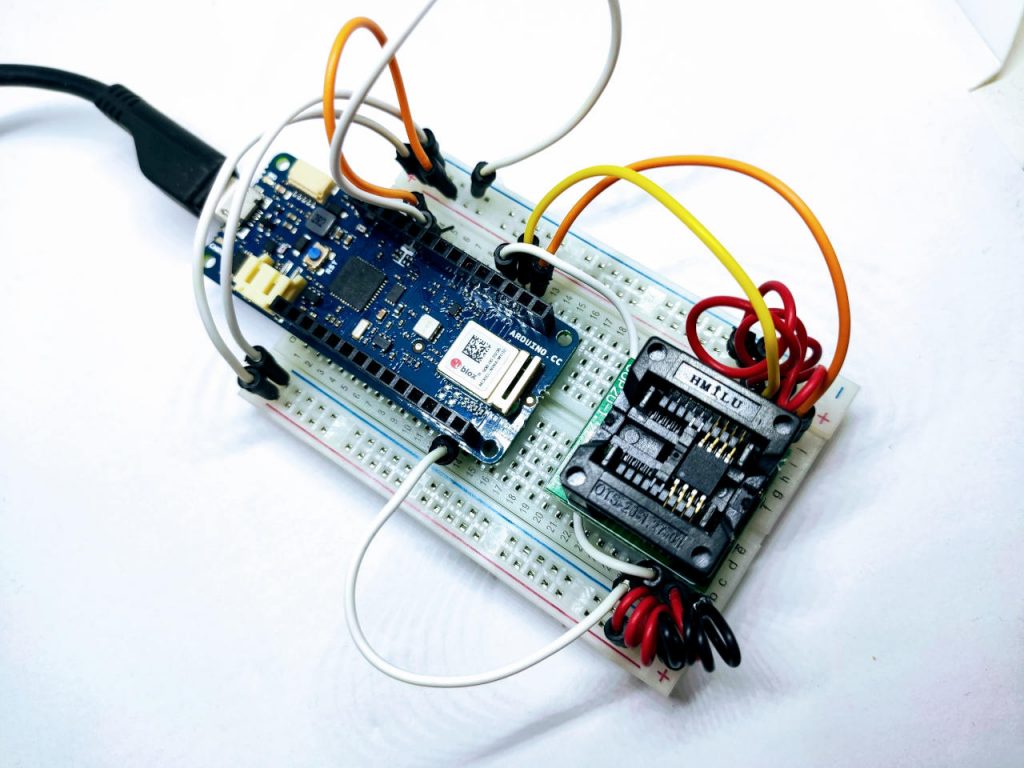
First of all, you must Format the SPI Flash; in the examples of Adafruit_SPIFlash, you can find the SdFat_format example, that format the SPI flash for you.
When you launch the sketch, It asks you to insert, in the Serial monitor, “OK” in camel case, here is the Serial output result.
Adafruit SPI Flash FatFs Format Example
Flash size: 1024 KB
Flash chip JEDEC ID: 0xEF4014
!!!!!!!!!!!!!!!!!!!!!!!!!!!!!!!!!!!!!!!!!!!!!!!!!!!!!!!!!!!!!!!!!!!!!
This sketch will ERASE ALL DATA on the flash chip and format it with a new filesystem!
Type OK (all caps) and press enter to continue.
!!!!!!!!!!!!!!!!!!!!!!!!!!!!!!!!!!!!!!!!!!!!!!!!!!!!!!!!!!!!!!!!!!!!!
>>Send to COM17: "OK"<<
Creating and formatting FAT filesystem (this takes ~60 seconds)...
Setting disk label to: EXT FLASH
Formatted flash!
Flash chip successfully formatted with new empty filesystem!
Now you are ready to use the SPI Flash with FAT FS.
If you want to use the file-system FAT, I advise using a SPIFlash with more than 1Mb of space.
Here is a simple sketch that creates a test.txt file with the string <num> -> testing 1, 2, 3. 100 times.
/*
* Add new txt file and add the string <num> -> testing 1, 2, 3. 100 times
* than read the file and put on serial output.
* library Adafruit_SPIFlash and SdFat - AdafruitFork
*
* by Mischianti Renzo <https://mischianti.org>
*
* https://mischianti.org/
*
* SPIFlash connected via SPI standard check wiring on the article
*
*/
#include "SdFat.h"
#include "Adafruit_SPIFlash.h"
Adafruit_FlashTransport_SPI flashTransport(SS, SPI); // Set CS and SPI interface
Adafruit_SPIFlash flash(&flashTransport);
// file system object from SdFat
FatFileSystem fatfs;
File myFile;
void setup()
{
Serial.begin(115200);
while ( !Serial ) delay(100); // wait for native usb
// // Settings for the Winbond W25Q80BV (1 MiB SPI flash.)
// // https://pdf1.alldatasheet.com/datasheet-pdf/view/555565/WINBOND/W25Q80BV.html
// #define W25X80BV \
// { \
// .total_size = (1UL << 20), /* 1 MiB */ \
// .start_up_time_us = 5000, .manufacturer_id = 0xef, \
// .memory_type = 0x40, .capacity = 0x14, .max_clock_speed_mhz = 104, \
// .quad_enable_bit_mask = 0x02, .has_sector_protection = false, \
// .supports_fast_read = true, .supports_qspi = true, \
// .supports_qspi_writes = true, .write_status_register_split = false, \
// .single_status_byte = false, .is_fram = false, \
// }
//
//
// /// List of all possible flash devices used by Adafruit boards
// static const SPIFlash_Device_t possible_devices[] = {
// // Main devices used in current Adafruit products
// W25X80BV,
// };
//if (flash.begin(possible_devices)) {
if (flash.begin()) {
Serial.println(F("Device finded and supported!"));
} else {
Serial.println(F("Problem to discover and configure device, check wiring also!"));
}
// Set 24Mhz SPI speed
// flashTransport.setClockSpeed(24000000, 24000000); // added to prevent speed problem
pinMode(LED_BUILTIN, OUTPUT);
flash.setIndicator(LED_BUILTIN, true);
Serial.println("Adafruit Serial Flash read write example");
Serial.print("JEDEC ID: "); Serial.println(flash.getJEDECID(), HEX);
Serial.print("Flash size: "); Serial.println(flash.size());
Serial.flush();
Serial.println();
// First call begin to mount the filesystem. Check that it returns true
// to make sure the filesystem was mounted.
if (!fatfs.begin(&flash)) {
Serial.println("Error, failed to mount newly formatted filesystem!");
Serial.println("Was the flash chip formatted with the SdFat_format example?");
while(1) yield();
}
Serial.println("Mounted filesystem!");
Serial.println();
// open the file. note that only one file can be open at a time,
// so you have to close this one before opening another.
myFile = fatfs.open("test.txt", FILE_WRITE);
// if the file opened okay, write to it:
if (myFile) {
Serial.print("Writing to test.txt...");
for (int i=0;i<100;i++){
myFile.print(i);
myFile.println(" -> testing 1, 2, 3.");
}
// close the file:
myFile.close();
Serial.println("done.");
} else {
// if the file didn't open, print an error:
Serial.println("error opening test.txt");
}
// re-open the file for reading:
myFile = fatfs.open("test.txt");
if (myFile) {
Serial.println("test.txt:");
// read from the file until there's nothing else in it:
while (myFile.available()) {
Serial.write(myFile.read());
}
// close the file:
myFile.close();
} else {
// if the file didn't open, print an error:
Serial.println("error opening test.txt");
}
}
void loop() {
// nothing happens after setup
}
The result becomes like so:
Device finded and supported!
Adafruit Serial Flash Speed Test example
JEDEC ID: EF4017
Flash size: 8388608
Mounted filesystem!
Writing to test.txt...done.
test.txt:
0 -> testing 1, 2, 3.
[...]
99 -> testing 1, 2, 3.
ets Jun 8 2016 00:22:57
Now we can call some command to retrieve the filesystem info and then get the list of files with the ls command.
/*
* Retrieve basic core info of Flash SPI
* Get size and free size
*
* than call ls command
*
* library Adafruit_SPIFlash and SdFat - AdafruitFork
*
* by Mischianti Renzo <https://mischianti.org>
*
* https://mischianti.org/
*
* SPIFlash connected via SPI standard check wiring on the article
*
*/
#include "SdFat.h"
#include "Adafruit_SPIFlash.h"
Adafruit_FlashTransport_SPI flashTransport(SS, SPI); // Set CS and SPI interface
Adafruit_SPIFlash flash(&flashTransport);
// file system object from SdFat
FatFileSystem fatfs;
void setup()
{
Serial.begin(115200);
while ( !Serial ) delay(100); // wait for native usb
// // Settings for the Winbond W25Q80BV (1 MiB SPI flash.)
// // https://pdf1.alldatasheet.com/datasheet-pdf/view/555565/WINBOND/W25Q80BV.html
// #define W25X80BV \
// { \
// .total_size = (1UL << 20), /* 1 MiB */ \
// .start_up_time_us = 5000, .manufacturer_id = 0xef, \
// .memory_type = 0x40, .capacity = 0x14, .max_clock_speed_mhz = 104, \
// .quad_enable_bit_mask = 0x02, .has_sector_protection = false, \
// .supports_fast_read = true, .supports_qspi = true, \
// .supports_qspi_writes = true, .write_status_register_split = false, \
// .single_status_byte = false, .is_fram = false, \
// }
//
//
// /// List of all possible flash devices used by Adafruit boards
// static const SPIFlash_Device_t possible_devices[] = {
// // Main devices used in current Adafruit products
// W25X80BV,
// };
//if (flash.begin(possible_devices)) {
if (flash.begin()) {
Serial.println(F("Device finded and supported!"));
} else {
Serial.println(F("Problem to discover and configure device, check wiring also!"));
}
// Set 24Mhz SPI speed
// flashTransport.setClockSpeed(24000000, 24000000); // added to prevent speed problem
pinMode(LED_BUILTIN, OUTPUT);
flash.setIndicator(LED_BUILTIN, true);
Serial.println("Adafruit Serial Flash Speed Test example");
Serial.print("JEDEC ID: "); Serial.println(flash.getJEDECID(), HEX);
Serial.print("Flash size: "); Serial.println(flash.size());
Serial.flush();
Serial.println();
// First call begin to mount the filesystem. Check that it returns true
// to make sure the filesystem was mounted.
if (!fatfs.begin(&flash)) {
Serial.println("Error, failed to mount newly formatted filesystem!");
Serial.println("Was the flash chip formatted with the SdFat_format example?");
while(1) yield();
}
Serial.println("Mounted filesystem!");
Serial.println();
Serial.print("Clusters: ");
Serial.println(fatfs.clusterCount());
Serial.print("Blocks x Cluster: ");
Serial.println(fatfs.blocksPerCluster());
Serial.print("Total Blocks: ");
Serial.println(fatfs.blocksPerCluster() * fatfs.clusterCount());
Serial.println();
// print the type and size of the first FAT-type volume
uint32_t volumesize;
Serial.print("Volume type is: FAT");
Serial.println(fatfs.fatType(), DEC);
volumesize = fatfs.blocksPerCluster(); // clusters are collections of blocks
volumesize *= fatfs.clusterCount(); // we'll have a lot of clusters
volumesize /= 2; // SD card blocks are always 512 bytes (2 blocks are 1KB)
Serial.print("Volume size (Kb): ");
Serial.println(volumesize);
Serial.print("Volume size (Mb): ");
volumesize /= 1024;
Serial.println(volumesize);
Serial.println();
// print the type and size of the first FAT-type volume
volumesize = 0;
volumesize = fatfs.blocksPerCluster(); // clusters are collections of blocks
volumesize *= fatfs.freeClusterCount(); // we'll have a lot of clusters
volumesize /= 2; // SD card blocks are always 512 bytes (2 blocks are 1KB)
Serial.print("Free space size (Kb): ");
Serial.println(volumesize);
Serial.print("Free space size (Mb): ");
volumesize /= 1024;
Serial.println(volumesize);
Serial.println("\nFiles found on the card (name, date and size in bytes): ");
fatfs.rootDirStart();
// list all files in the card with date and size
fatfs.ls(LS_R | LS_DATE | LS_SIZE);
}
void loop(void) {
}
The result becomes
Device finded and supported!
Adafruit Serial Flash Speed Test example
JEDEC ID: EF4017
Flash size: 8388608
Mounted filesystem!
Clusters: 2043
Blocks x Cluster: 8
Total Blocks: 16344
Volume type is: FAT12
Volume size (Kb): 8172
Volume size (Mb): 7
Free space size (Kb): 8164
Free space size (Mb): 7
Files found on the card (name, date and size in bytes):
2000-01-01 01:00:00 7170 test.txt
Thanks
- Arduino SAMD NINA: pinout, specs and Arduino IDE configuration
- Arduino SAMD NINA: WiFiNINA, firmware update, and RGB led
- Arduino SAMD (NANO 33 and MKR): SPI flash memory FAT FS
- i2c Arduino SAMD MKR: additional interface SERCOM, network and address scanner
- Arduino MKR SAMD: FAT filesystem on external SPI flash memory

